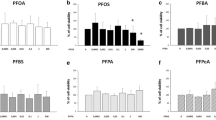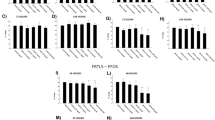Abstract
Perfluorooctanoic acid (PFOA) and perfluorooctane sulfonate (PFOS) are widely used perfluorinated chemicals (PFCs). Previous studies detected PFOA and PFOS in human tissues including the thyroid gland. There are no studies on the in vitro effects of PFOA and PFOS on thyroid cells. Our study was aimed at evaluating the effect of the in vitro exposure to PFOA and PFOS on thyroid cell proliferation and viability. These objectives were investigated using Fisher rat thyroid line-5 (FRTL-5) cells. FRTL-5 cells cultured in the presence of PFOA and PFOS at concentrations up to 104 nM do not display changes in their viability and proliferation rate, while at a concentration of 105 nM of either PFCs, a significant inhibition of cell proliferation, mainly due to increased cell death, was found. PFOA and PFOS were detected in FRTL-5 cell pellets after 72 h of incubation with PFCs but not in control cultures. When FRTL-5 were incubated with PFCs then washed in PBS and re-cultured for 72 h without PFCs in the medium, no detectable concentrations of PFOA and PFOS were measured in the cell pellet. This indicates that PFOA and PFOS enter thyroid cells by a gradient-based passive diffusion mechanism. Future studies are required to evaluate the potential toxic effect resulting from prolonged in vivo exposure to even lower concentrations of PFCs.



Similar content being viewed by others
References
Alexander BH, Olsen GW, Burris JM, Mandel J, Mandel JS (2003) Mortality of employees of a perfluorooctanesulphonyl fluoride manufacturing facility. Occup Environ Med 60:722–729
Alexander BH, Olsen GW (2007) Bladder cancer in perfluorooctanesulfonyl fluoride manufacturing workers. Ann Epidemiol 17:471–478
Berger U, Glynn A, Holmstro KE, Berglund M, Ankarberg EH, Törnkvist A (2009) Fish consumption as a source of human exposure to perfluorinated alkyl substances in Sweden—analysis of edible fish from Lake Vättern and the Baltic Sea. Chemosphere 76:799–804
Boltes K, Rosal R, Garcia-Calvo E (2012) Toxicity of mixtures of perfluorooctane sulphonic acid with chlorinated chemicals and lipid regulators. Chemosphere 86:24–29
Brieger A, Bienefeld N, Hasan R, Goerlich R, Haase H (2003) Impact of perfluorooctanesulfonate and perfluorooctanoic acid on human peripheral leukocytes. Toxicol in Vitro 25:960–968
Butenhoff J, Costa G, Elcombe C, Farrar D, Hansen K, Iwai H, Jung R, Kennedy G Jr, Lieder P, Olsen G, Thomford P (2002) Toxicity of ammonium perfluorooctanoate in male cynomolgus monkeys after oral dosing for 6 months. Toxicol Sci 69:244–257
Chang SC, Thibodeaux JR, Eastvold ML, Ehresman DJ, Bjork JA, Froehlich JW, Lau C, Singh RJ, Wallace KB, Butenhoff JL (2008) Thyroid hormone status and pituitary function in adult rats given oral doses of perfluorooctanesulfonate (PFOS). Toxicology 243:330–339
Costa G, Sartori S, Consonni D (2009) Thirty years of medical surveillance in perfluooctanoic acid production workers. J Occup Environ Med 51:364–372
Geiger SD, Xiao J, Ducatman A, Frisbee S, Innes K, Shankar A (2013) The association between PFOA, PFOS and serum lipid levels in adolescents. Chemosphere 98:78–83
DIRECTIVE 2006/122/ECOF THE EUROPEAN PARLIAMENT AND OF THE COUNCIL, of 12 December 2006, Official Journal of the European Union, L. 372/32, 2006.
Emmett EA, Zhang H, Shofer FS, Freeman D, Rodway NV, Desai C, Shaw LM (2006) Community exposure to perfluorooctanoate: relationships between serum levels and certain health parameters. J Occup Environ Med 48:771–779
EFSA (2008) European Food Safety Authority opinion of the scientific panel on contaminants in the food chain on perfluorooctane sulfonate (PFOS) or perfluorooctanoic (PFOA) acid and their salts. EFSA J 653:1–131
Florentin A, Deblonde T, Diguio N, Hautemaniere A, Hartemann P (2011) Impacts of two perfluorinated compounds (PFOS and PFOA) on human hepatoma cells: cytotoxicity but no genotoxicity? Int J Hyg Environ Health 214:493–499
Genuis SJ, Beesoon S, Birkholz D (2013) Biomonitoring and elimination of perfluorinated compounds and polychlorinated biphenyls through perspiration: blood, urine, and sweat study. ISRN Toxicol 2013:483832
Gutshall DM, Pilcher GD, Langley AE (1989) Mechanism of the serum thyroid hormone lowering effect of perfluoro-n-decanoic acid (PFDA) in rats. J Toxicol Environ Health 28:53–65
Han X, Kemper RA, Jepson GW (2005) Subcellular distribution and protein binding of perfluorooctanoic acid in rat liver and kidney. Drug Chem Toxicol 28:197–209
Hu W, Jones PD, DeCoen W, King L, Fraker P, Newsted J, Giesy JP (2003) Alterations in cell membrane properties caused by perfluorinated compounds. Comp Biochem Physiol C Toxicol Pharmacol 135:77–88
Inoue K, Okada F, Ito R, Kato S, Sasaki S, Nakajima S, Uno A, Saijo Y, Sata F, Yoshimura Y, Kishi R, Nakazawa H (2004) Perfluorooctane sulfonate (PFOS) and related perfluorinated compounds in human maternal and cord blood samples: assessment of PFOS exposure in a susceptible population during pregnancy. Environ Health Perspect 112:1204–1207
Jones P, Hu W, De coen W, Newsted J, Giesy J (2003) Binding of perfluorinated fatty acids to serum proteins. Environ Toxicol Chem 22:2639–2649
Kannan K, Corsolini S, Falandysz J, Fillmann G, Kumar KS, Loganathan BG, Mohd MA, Olivero J, van Wouwe N, Yang JH, Aldous KM (2004) Perfluorooctanesulfonate and related fluorochemicals in human blood from several countries. Environ Sci Technol 38:4489–4495
Kleszczynski K, Skladanowski AC (2009) Mechanism of cytotoxic action of perfluorinated acids: I. Alteration in plasma membrane potential and intracellular pH level. Toxicol Appl Pharmacol 234:300–305
Lau C, Anitole K, Hodes C, Lai D, Pfahles-Hutchens A, Seed J (2007) Perfluoroalkyl acids: a review of monitoring and toxicological findings. Toxicol Sci 99:366–394
Liu C, Gin KY, Chang VW, Goh BP, Reinhard M (2011) Novel perspectives on the bioaccumulation of PFCs—the concentration dependency. Environ Sci Technol 45:9758–9764
Liu C, Gin KY, Chang VW (2014) Multi-biomarker responses in green mussels exposed to PFCs: effects at molecular, cellular, and physiological levels. Environ Sci Pollut Res Int 21:2785–2794
Maestri L, Negri S, Ferrari M, Ghittori S, Fabris F, Danesino P, Imbriani M (2006) Determination of perfluorooctanoic acid and perfluorooctanesulfonate in human tissues by liquid chromatography=single quadrupole mass spectrometry. Rapid Commun Mass Spectrom 20:2728–2734
Melzer D, Rice N, Depledge MH, Henley WE, Galloway TS (2010) Association between serum perfluorooctanoic acid (PFOA) and thyroid disease in the U.S. National Health and Nutrition Examination Survey. Environ Health Perspect 118:686–692
Narimatsu S, Nakanishi R, Hanioka N, Saito K, Kataoka H (2011) Characterization of inhibitory effects of perfluorooctane sulfonate on human hepatic cytochrome P450 isoenzymes: focusing on CYP2A6. Chem Biol Interact 194:120–126
Nelson JW, Hatch EE, Webster TF (2010) Exposure to polyfluoroalkyl chemicals and cholesterol, body weight, and insulin resistance in the general US population. Environ Health Perspect 118:197–202
Olsen GW, Burris JM, Ehresman DJ, Froehlich JW, Seacat AM, Butenhoff JL, Zobel LR (2007) Half-life of serum elimination of perfluorooctanesulfonate, perfluorohexanesulfonate, and perfluorooctanoate in retired fluorochemical production workers. Environ Health Perspect 115:1298–1305
Pirali B, Negri S, Chytiris S, Perissi A, Villani L, La Manna L, Cottica D, Ferrari M, Imbriani M, Rotondi M, Chiovato L (2009) Perfluorooctane sulfonate and perfluorooctanoic acid in surgical thyroid specimens of patients with thyroid diseases. Thyroid 12:1407–1412
Seacat AM, Thomford PJ, Hansen KJ, Clemen LA, Eldridge SR, Elcombe CR, Butenhoff JL (2003) Sub-chronic dietary toxicity of potassium perfluorooctanesulfonate in rats. Toxicology 183:117–131
Sedlak MD, Greig DJ (2012) Perfluoroalkyl compounds (PFCs) in wildlife from an urban estuary. J Environ Monit 14:146–154
Shan G, Ye M, Zhu B, Zhu L (2013) Enhanced cytotoxicity of pentachlorophenol by perfluorooctane sulfonate or perfluorooctanoic acid in HepG2 cells. Chemosphere 93:2101–2107
Song C, Chen P, Wang C, Zhu L (2012) Photodegradation of perfluorooctanoic acid by synthesized TiO2-MWCNT composites under 365 nm UV irradiation. Chemosphere 86:853–859
UK FSA (United Kingdom Food Standards Agency) (2006) Fluorinated chemicals: UK dietary intakes www.food.gov.uk/multimedia/pdfs/fsis1106.pdf
U.S. EPA. (Unites States Environmental Protection Agency) (2006) The 2010/2015 PFOA Stewardship Program. http://www.epa.gov/oppt/pfoa/pubs/stewardship/index.html
Van den Heuvel J, Thompson J, Frame S, Gillies PJ (2006) Differential activation of nuclear receptors by perfluorinated fatty acid analogs and natural fatty acids: a comparison of human, mouse, and rat peroxisome proliferator-activated receptor-alpha, -beta, and -gamma, liver X receptor-beta, and retinoid X receptor-alpha. Toxicol Sci 92L:476–489
Vassiliadou I, Costopoulou D, Ferderigou A, Leondiadis L (2010) Levels of perfluorooctanesulfonate (PFOS) and perfluorooctanoate (PFOA) in blood samples from different groups of adults living in Greece. Chemosphere 80:1199–1206
Wen LL, Lin LY, Su TC, Chen PC, Lin CY (2013) Association between serum perfluorinated chemicals and thyroid function in U.S. adults: the National Health and Nutrition Examination Survey 2007–2010. J Clin Endocrinol Metab 98:E1456–E1464
Zareitalabad P, Siemens J, Hamer M, Amelung W (2013) Perfluorooctanoic acid (PFOA) and perfluorooctanesulfonic acid (PFOS) in surface waters, sediments, soils and wastewater—a review on concentrations and distribution coefficients. Chemosphere 91:725–732
Author information
Authors and Affiliations
Corresponding author
Additional information
Responsible editor: Philippe Garrigues
Rights and permissions
About this article
Cite this article
Coperchini, F., Pignatti, P., Lacerenza, S. et al. Exposure to perfluorinated compounds: in vitro study on thyroid cells. Environ Sci Pollut Res 22, 2287–2294 (2015). https://doi.org/10.1007/s11356-014-3480-9
Received:
Accepted:
Published:
Issue Date:
DOI: https://doi.org/10.1007/s11356-014-3480-9




